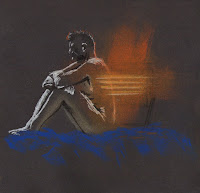Churchill Ongere- 'Greener Pastures
and the Colours of Youth'
Norman McLAren- 'Boogie Doodle'
Oskar Fischinger- 'An Optical Poem'
Meanwhile I sent Churchill a series of questions about his painting.
- What materials were used to create the artwork?
- What does your artwork represent?
- If your artwork could move, how would you imagine it to move?
These were his responses...
Materials:
I use straw board as my surface and use all available types of paper to make my images and background. In The Human Condition: Greener Pastures and the Colours of Youth, the abstract image is made up of different colours of embossed paper and the background is made up of small pieces of cut printing paper. I use book binding glue to stick the pieces of paper on the straw board.
I use straw board as my surface and use all available types of paper to make my images and background. In The Human Condition: Greener Pastures and the Colours of Youth, the abstract image is made up of different colours of embossed paper and the background is made up of small pieces of cut printing paper. I use book binding glue to stick the pieces of paper on the straw board.
What this work represents:
'...The human condition is one of ups and downs. We use colours to represent what we feel, think and even expect. The youth are usually very colourful and bright in how they dress and approach life. The colour green represents hopes of a better future for the young people. In the composition of this abstract piece, the green also forms a hand (an important part of our bodies that is used to accomplish almost all tasks)
The orange shows how the young people dress very colourfully. The angle of the leg shows there is some element of discomfort (that as much as it is good to seek greener pastures, there are also challenges to this.)
Red represents love and passim and the two black and yellow circles form an eye that looks like a person who is in shock or even excited.
The background represents the conversations that people have about others. All these represent the human condition. I have had other people interpret this piece differently on their first encounter with it (which is always interesting and invited)- which also goes to show how the human being is analysed differently by other people.
Motion:
'I imagine this piece being a living creature that goes through difficult and good times while interacting with other creatures.
As for the music, please use any music that is popular among the youth. In addition to that, I have this imagination for how the animated video can look. The video starts with the four different parts of the image coming into the screen one after the other. (The yellow and black circles that form the eyem the green art that forms the nose and the arm of the figure, the leg and shoe made up if the orange and black and the lips made up of red and white). These can come into the screen to finally form the figure as it is like the figure is of a person who is falling from a high point.'
Having heard Churchill's vision of various parts of the artwork popping into view piece by piece and also the concept of the abstraction being a creature. The first samples that came to mind were the introductory titles of the Pixar Film 'Monsters Inc.' I was inspired by the way the elements pop in and out to the beat of the music.
'Monsters Inc'- by Pixar
Meanwhile a second slightly more 'out-there' inspiration was an episode of the children's TV show 'Pocoyo'. I was fascinated by the way in which the bird character 'Pato' moves and interacts as a creature but also a crazy abstraction of shapes in this 'Dance off' episode. I feel this broken up squashy and stretchy character motion might suit the 'Greener Pastures and the Colours of Youth' elements. Though perhaps not to the same extremes!
'Pocoyo'- by Zinkia Entertainment, Cosgrove Hall films, Granada International























